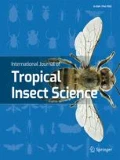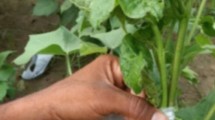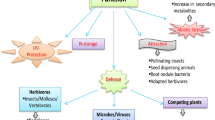Abstract
Elucidation of relationships between secondary metabolites and infestation caused by chickpea leafminer Liriomyza cicerina (Diptera: Agromyzidae) is of importance for managing leafminer in sustainable agriculture. In order to prevent agricultural crops losses caused by leafminer in the field, the insect monitoring is often required. In this work, we studied the role of secondary metabolites as response to infestations caused by chickpea leafminer. The study carried out on three chickpea Cicer arietinum varieties namely Beja1, Nour and Nayer. Furthermore, phenol, flavonoid contents and antioxidant activity were determined on infested and non-infested chickpea plants. In addition, protein contents were compared between seeds from non-infested and infested plants. Investigations were accomplished during three developmental crop stages (Vegetative, flowering and pod setting). Results showed that the highest infestation levels were recorded during pod setting stage. Moreover, our data revealed the presence of significant and negative correlations between total phenols and infestation (r = −0.751, P < 0.01) and between flavonoids levels and infestation percentage (r = −0.971, P ≤ 0.01). Our data demonstrated that chickpea leafminer is a serious pest causing damage on chickpea production and industry. Besides, results showed that the secondary metabolites including total phenols and flavonoids in three chickpea varieties were found to be higher level in infested plants than those of control at three growth stages indicating that chickpea plant may be protected by its secondary metabolites against the chickpea leafminer.


Similar content being viewed by others
References
Amor-Prats D, Harborne JB (1993) New sources of ergoline alkaloids within the genus ipomoea. Biochem Syst Ecol 21:455–461
Aoun A (2004) The performance of Tunisian agriculture: an economic appraisal. New Medit 3:4–7
Bi J, Murphy J, Felton G (1997) Antinutritive and oxidative components as mechanisms of induced resistance in cotton to helicoverpa zea. J Chem Ecol 23:97–117
Bernays E, Chapman R. (1994) Chemicals in plants. Host-plant selection by phytophagous insects 14–60
Bolton MD (2009) Primary metabolism and plant defense—fuel for the fire. Mol Plant-Microbe Interact 22:487–497
Cikman E, Kaplan M (2008). Effects of azadirachtin a [Azadirachta indica a Juss (Meliacea)] on larval serpentine leafminers Liriomyza cicerina (Rondani, 1875)(Díptera: Agromyzidae) in chickpea. J Appl Sci Res 1143–1148
Clé C, Hill LM, Niggeweg R, Martin CR, Guisez Y, Prinsen E, Jansen MAK (2008) Modulation of chlorogenic acid biosynthesis in Solanum lycopersicum; consequences for phenolic accumulation and UV-tolerance. Phytochemistry 69:2149–2156
Dar G, Umar A, Zaidi S, Ibrahim AA, Abaker M, Baskoutas S et al (2012) Ce-doped ZnO nanorods for the detection of hazardous chemical. Sensors Actuators B Chem 173:72–78
Dewanto V, Wu X, Adom KK, Liu RH (2002) Thermal processing enhances the nutritional value of tomatoes by increasing total antioxidant activity. J Agric Food Chem 50:3010–3014
Djeridane A, Yousfi M, Nadjemi B, Boutassouna D, Stocker P, Vidal N (2006) Antioxidant activity of some Algerian medicinal plants extracts containing phenolic compounds. Food Chem 97:654–660
Fink RC, Evans MR, Porwollik S, Vazquez-Torres A, Jones-Carson J, Troxell B, Libby SJ, McClelland M, Hassan HM (2007) FNR is a global regulator of virulence and anaerobic metabolism in salmonella enterica serovar Typhimurium (ATCC 14028s). J Bacteriol 189:2262–2273
Gill R, Gupta A, Taggar G, Taggar M (2010) Role of oxidative enzymes in plant defenses against insect herbivory. Acta Phytopathol Entomol Hungarica 45:277–290
Haouel-Hamdi S, Titouhi F, Boushih E, Dhraief M, Amri M, Mediouni Ben Jemâa J (2017) Population demographic and reproductive parameters of the cowpea seed beetle Callosobruchus maculatus infesting stored lentil and chickpea commodities. Tunis J Plant Prot 12:67–81
Hatano T, Kagawa H, Yasuhara T, Okuda T (1988) Two new flavonoids and other constituents in licorice root: their relative astringency and radical scavenging effects. Chem Pharm Bull 36:2090–2097
Heimler D, Vignolini P, Dini MG, Romani A (2005) Rapid tests to assess the antioxidant activity of Phaseolus vulgaris L. dry beans. J Agric Food Chem 53:3053–3056
Helmi A, Mohamed HI (2016) Biochemical and ultrastructural changes of some tomato cultivars after infestation with Aphis gossypii glover (Hemiptera: Aphididae) at Qalyubiyah, Egypt. Gesunde Pflanzen 68:41–50
Huang W, Ratkowsky DA, Hui C, Wang P, Su J, Shi P (2019) Leaf fresh weight versus dry weight: which is better for describing the scaling relationship between leaf biomass and leaf area for broad-leaved plants? Forests 10:256
Jukanti AK, Gaur PM, Gowda C, Chibbar RN (2012) Nutritional quality and health benefits of chickpea (Cicer arietinum L.): a review. Br J Nutr 108:11–26
Kaur H, Salh P, Singh B (2017) Role of defense enzymes and phenolics in resistance of wheat crop (Triticum aestivum L.) towards aphid complex. J Plant Interact 12:304–311
Kerchev PI, Fenton B, Foyer CH, Hancock RD (2012) Plant responses to insect herbivory: Interactions between photosynthesis, reactive oxygen species and hormonal signalling pathways. Plant Cell Environ 35:441–453
Kessler A, Baldwin IT (2002) Plant responses to insect herbivory: the emerging molecular analysis. Annu Rev Plant Biol 53:299–328
Khetarpaul N (2018) Total mineral content present (calcium, magnesium, potassium, phosphorus, Iron, zinc, manganese, copper, and boron and nickel) in leaves of Desi and Kabuli chickpea varieties (on dry matter basis). Int J Chem Stud 6:633–635
Kjeldahl C (1883) A new method for the determination of nitrogen in organic matter. Z Anal Chem 22:366–382
Koes RE, Quattrocchio F, Mol JN (1994) The flavonoid biosynthetic pathway in plants: function and evolution. BioEssays 16:123–132
Kumar NV, Murthy PS, Manjunatha J, Bettadaiah B (2014) Synthesis and quorum sensing inhibitory activity of key phenolic compounds of ginger and their derivatives. Food Chem 159:451–457
Lahmar M, Zeouienne M (1990) Donnèes bio-ecologiques et importance des dègats de la mineuse du pois-chiche (Liriomyza cicerina, Rond.) au Maroc. Al Awamia 26:108–118
Lindroth RL, Scriber JM, Hsia MS (1988) Chemical ecology of the tiger swallowtail: mediation of host use by phenolic glycosides. Ecology 69:814–822
Mbarek KB, Boubaker M (2013) Evaluation of kabuli chickpea genotypes (cicer arietinum l.) collection under tunisian semi arid conditions. Octa J Environ Res 1
Macar TK, Macar O, Mart Dİ (2017) Variability in Some Biochemical and Nutritional Characteristics in Desi and Turkish Kabuli Chickpea (Cicer arietinum L.) Types. Celal Bayar Üniversitesi Fen Bilimleri Dergisi 13: 677–680
Mazid M, Khan T, Mohammad F (2011) Role of secondary metabolites in defense mechanisms of plants. Biol Med 3:232–249
Mierziak J, Wojtasik W, Kostyn K, Czuj T, Szopa J, Kulma A (2014) Crossbreeding of transgenic flax plants overproducing flavonoids and glucosyltransferase results in progeny with improved antifungal and antioxidative properties. Mol Breed 34:1917–1932
Oszmiański J, Kolniak-Ostek J, Biernat A (2015) The content of phenolic compounds in leaf tissues of Aesculus glabra and Aesculus parviflora Walt. Molecules 20:2176–2189
Ouji A, El-Bok S, Mouelhi M, Ben-Younes M, Kharrat M (2017) Yield and yield components of chickpea (Cicer arietinum L.) as influenced by supplemental irrigation under semi-arid region of Tunisia. World J Agric Res 5:153–157
Pan Z, Li Y, Deng X, Xiao S (2014) Non-targeted metabolomic analysis of orange (Citrus sinensis [L.] Osbeck) wild type and bud mutant fruits by direct analysis in real-time and HPLC-electrospray mass spectrometry. Metabolomics 10:508–523
Rattan RS (2010) Mechanism of action of insecticidal secondary metabolites of plant origin. Crop Prot 29:913–920
Saharan K, Khetarpaul N (1994) Protein quality traits of vegetable and field peas: varietal differences. Plant Foods Hum Nutr 45:11–22
Salem F (2017) First survey of agricultural pesticides used for crops in Ichkeul Lake–Bizerte lagoon watershed (Tunisia). Environ Sci Ind J 13:156
Schwachtje J, Baldwin IT (2008) Why does herbivore attack reconfigure primary metabolism? Plant Physiol 146:845–851
Shevtchenko M (1937) Liriomyza cicerina Rond., and its importance to cultivation of Cicer arietinum. Plant Prot 12:159–170
Singleton VL, Rossi JA (1965) Colorimetry of total phenolics with phosphomolybdic-phosphotungstic acid reagents. Am J Enol Vitic 16:144–158
Soltani A, Beyareslan A, Gençer L, Hamdi SH, Bousselmi A, Amri M et al (2018) Parasitoids of chickpea leafminer Liriomyza cicerina (Diptera: Agromyzidae) and their parasitism rate on chickpea fields in North Tunisia. J Asia Pac Entomol 21:1215–1221
Sonwa DJ, Coulibaly O, Weise SF, Adesina AA, Janssens MJ (2008) Management of cocoa: constraints during acquisition and application of pesticides in the humid forest zones of southern Cameroon. Crop Prot 27:1159–1164
Thompson GA, Goggin FL (2006) Transcriptomics and functional genomics of plant defence induction by phloem-feeding insects. J Exp Bot 57:755–766
Toker C, Erler F, Ceylan FO, Canci H (2010) Severity of leaf miner [Liriomyza cicerina (Rondani, 1875)(Diptera: Agromyzidae)] damage in relation to leaf type in chickpea. Turk Entomol Derg 34:211–225
Vorwerk S, Somerville S, Somerville C (2004) The role of plant cell wall polysaccharide composition in disease resistance. Trends Plant Sci 9:203–209
Walling LL (2000) The myriad plant responses to herbivores. J Plant Growth Regul 19:195–216
Weigand S (1990) Development of an integrated pest management system in food legumes in the Icarda region. Proceedings: Integrated Pest Management in Tropical and Subtropical Cropping Systems' 89:53–76
Wink M (2018) Introduction: biochemistry, physiology and ecological functions of secondary metabolites. Ann Plant Rev online 1–19
Wink M, Schimmer O (1999) Mode of action of defensive secondary metabolites. In: Wink M (ed), Function of plant secondary metabolites and their exploitation in biotechnology. Annual plant reviews, 3’ Sheffield academic press, CRC Press: Sheffield, England, pp. 17–133
Zarai T (2017) Les pesticides à usage agricole en Tunisie « Cadre réglementaire & proCédure d’homologation». Utilisation des pesticides dans la production agricole: entre enjeux économiques et santé humaine. Ministère de l’agriculture des ressources hydrauliques et de la pêche
Author information
Authors and Affiliations
Corresponding author
Ethics declarations
Conflict of interest
Author Abir Soltani declares that she has no conflict of interest. Author Yosr Zaouali declares that she has no conflict of interest. Author Soumaya Haoual-Hamdi declares that she has no conflict of interest. Author Dalel Saadouni declares that she has no conflict of interest. Author Moez Amri declares that he has no conflict of interest. Author Antonio Carapelli declares that he has no conflict of interest. Author Jouda Mediouni Ben Jemâa declares that she has no conflict of interest.
Additional information
Publisher’s note
Springer Nature remains neutral with regard to jurisdictional claims in published maps and institutional affiliations.
Rights and permissions
About this article
Cite this article
Soltani, A., Zouali, Y., Haoual-Hamdi, S. et al. Relationship between secondary metabolites and infestations caused by chickpea leafminer Liriomyza cicerina (Diptera:Agromyzidae). Int J Trop Insect Sci 41, 251–259 (2021). https://doi.org/10.1007/s42690-020-00200-0
Received:
Accepted:
Published:
Issue Date:
DOI: https://doi.org/10.1007/s42690-020-00200-0




